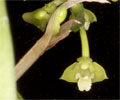|
|
|
|
 |
Email Address Recovery or Password Reset |
Use our Change Password page, and you can set a new password, or if you don't remember which email address you
registered with, the same page may be able to suggest it based on another you enter.
|
|
|
|
|
| |
Flasks of
Polystachya concreta 'MC3663' -spontaneous |
|
| |
|
|
| |
| Number: |
TN5495 |
| Name: |
Polystachya concreta 'MC3663' -spontaneous
(Acquired incorrectly named as Polystachya foliosa)
|
| Type: |
spontaneous (What's that?) |
|
Click to Enlarge

Offspring 'MC5097' Inflorescence |
Click to Enlarge

Offspring 'MC5097' Flower from Below |
| Offspring photos are siblings of the plants you would receive. |
|
|
|
| |
Culture Notes from Donor: Parent plant: Temperature range I (60-83°F)
Comments: Parent plant: Medium-sized plant from Cerra de Punta in Puerto Rico.
For additional origin/habitat information supplied courtesy of
Charles and Margaret Baker, see further below, near the bottom of this page.
|
Temperatures we attempt to use in the lab & greenhouse:
| For Species: |
|
Spring, Summer, Autumn: days average 90°F, nights 70°F; best fit is Warm 90-70°F
(Source:
Baker's Web OSC) |
| For Species: |
|
Winter: days average 79°F, nights 55°F; best fit is Cool-Intermediate 75-58°F
(Source:
Baker's Web OSC) |
|
About the name...
| Etymology of |
concreta |
|
From Latin "concretus" compressed, standing tight.
(Source:
Mayr & Schmucker 1998) |
| Etymology of |
Polystachya |
|
From latinized Greek "poly" many; "stachys" grain ear. Sometimes the raceme bears flower remnants from previous years.
(Source:
Mayr & Schmucker 1998) |
| Pronunciation of |
Polystachya |
|
pol-ee-STAK-ee-ah
(Source:
Hawkes 1978) |
|
If you would like to direct someone to this web page, please copy and paste this URL into your email:
http://troymeyers.com/d?015495
| Flask Information |
| Availability: |
We have sold all of the flasks for this item. |
| You should: |
Consider getting individual plants or compots instead of a flask.
You can place a "Notify Flask Recipients" Request, and either we or a flask recipient may contact you when plants are available.
You may also place a "Notify Retries" Request, and if an identical pollination (the same parents) is done again, we'll let you know.
You may reserve a flask, but it's very unlikely you'll get one ...this could only happen if we found a flask that we didn't know we had. |
| Yield Estimate: |
180 plants (based on flask surveys done 09/25/2006 through 09/26/2006)
|
| Plantlet Sizes: |
From many flasks 10 - 60 mm plants (based on flask surveys done 09/25/2006 through 04/10/2007)
From one most recently surveyed flask 30 - 60 mm (04/10/2007)
|
|
You might also want to:
|
View the seed assay for this item.
View items of the same species.
View items of the same genus.
|
| Ordering Information |
| You are not currently logged in. |
|
You must be a registered user and be logged in to reserve a flask or place a notification request. Please log in:
|
|
 |
Email Address Recovery or Password Reset |
Use our Change Password page, and you can set a new password, or if you don't remember which email address you
registered with, the same page may be able to suggest it based on another you enter.
|
|
|
|
|
|
|
|
| |
The origin/habitat information below is supplied courtesy of Charles and Margaret Baker
The following information is based on the name of the plant provided by the donor, and assumes that the name is correct. If the plant has been misidentified, then the following information may not be correct.
This text is copyrighted by the Bakers and may not be reproduced without permission.
ORIGIN/HABITAT: Widespread throughout the tropical regions of the world.
In the old world, this normally epiphytic orchid is found in India, Sri
Lanka, the Nicobar Islands, Thailand, Laos, Vietnam, Peninsular Malasia,
Indonesia, Borneo, the Philippines, tropical Africa, and Madagascar. In
the new world, plants are found in Florida, Mexico, Belize, Guatemala,
Honduras, Nicaragua, Costa Rica, Venezuela, Guyana, Surinam, Colombia,
Ecuador, Brazil, the West Indies, In most regions, plants grow in wet or
moist lowland forests, but in warmer regions, plants have been found at
elevations up to 4600 ft. (1400 m). In Java, plants reportedly are common
all over the island from 150 ft. (50 m) to more than 3300 ft. (1000 m).
More about this information and the Bakers...
|
|
|
| |
|
|
|